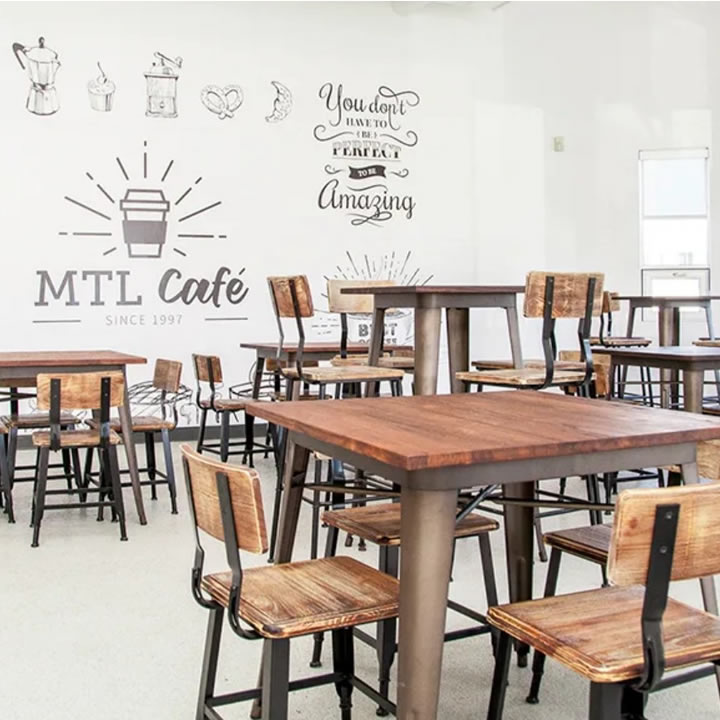A new actor has emerged in the ever-changing landscape of the restaurant sector, where customer experience reigns supreme, set to revolutionize the way we dine.
The Internet of Things (IoT), a tremendous technological force, is being interwoven into restaurant furniture, ushering in a new era in which eating is more than just about the food, but also about an immersive, connected experience.
Smart Restaurant Furniture: The Basics
The concept of smart restaurant furniture is at the heart of this revolution.
These are not just restaurant tables and restaurant chairs, but complex, networked electronics. To improve the eating experience, they add a variety of IoT components such as sensors, connections, and interactive elements.
These smart furniture elements are meant to perfectly mix technology and aesthetics, preserving the restaurant’s ambiance and functionality.
Restaurant owners now have a unique chance to respond to shifting diner expectations by providing levels of involvement and personalization that were formerly science fiction.
The Advantages of IoT-Connected Furniture
The introduction of IoT-connected furniture provides numerous benefits to both customers and restaurant operators.
Customers will benefit from increased convenience and engagement.
Consider walking into a restaurant where your table automatically charges your devices, provides interactive digital menus, and allows you to personalize your dining experience. These improvements give users more power and personalization.
IoT-connected furniture simplifies operations for restaurant owners.
Owners may enhance menu options, modify pricing, and even eliminate food waste using real-time data collection. The benefits of sustainability are also obvious, as these advancements enable energy-efficient lighting and environmental monitoring.
Types of Smart Restaurant Furniture
Smart Tables: These tables have a variety of features and capabilities.
Wireless charging, digital menus, and customizable ordering are all available to customers. The tables can also be integrated with reservation systems, have different lighting and temperature settings, and even allow for sanitary self-cleaning.
Additional innovations that improve the dining experience include feedback collection, seamless Wi-Fi connectivity, and interactive displays.
Interactive Seating: Restaurant chairs now provide more than simply a place to sit. Personal comfort settings and interaction with client devices are among the interactive seating choices.
They offer characteristics such as entertainment, gamification, and accessibility. Dynamic seating configurations and voice-activated control meet a wide range of customer requirements, and chair materials prioritize durability and sustainability.
Connectivity and Personalization
IoT integration in restaurant furniture has revolutionized connectivity and personalization. Wireless charging solutions are a game-changer for modern diners, as they can power their devices without searching for outlets.
Digital menus and ordering systems offer interactive visuals and recommendations based on past orders, enhancing overall convenience. Customer data is harnessed for customization and personalization, allowing restaurants to cater to individual preferences.
Sustainability and Environmental Considerations
In an era of increased environmental consciousness, IoT-connected furniture contributes to sustainability efforts. These pieces are constructed using sustainable materials, and they incorporate energy-efficient technologies to minimize the restaurant’s carbon footprint.
By reducing paper usage, digitalization minimizes waste, and waste management systems ensure responsible disposal of restaurant waste. As such, customers can dine with a cleaner conscience.
Challenges and Considerations
While the benefits of IoT-connected furniture are numerous, challenges exist. The initial investment and maintenance costs can be substantial.
Data security and privacy concerns must be addressed, and both staff and customers need to be trained in utilizing this innovative technology. Balancing technology with the traditional dining atmosphere can be a challenge.
Addressing technical glitches, ensuring compatibility, and managing customer expectations are ongoing considerations.
Future Trends and Innovations
The future of smart restaurant furniture holds exciting possibilities. Augmented and virtual reality are set to enhance the dining experience. AI-driven automation promises increased efficiency, and robotics may play a role in restaurant furniture and service.
Eco-conscious and sustainable designs will become increasingly prominent, and blockchain technology may provide secure transactions and data storage. Advanced voice and gesture controls, along with deeper integration with wearable devices and personal assistants, are also on the horizon.
Maximizing the Potential of IoT Integration
The incorporation of IoT into commercial restaurant furniture does not end with customer-facing improvements. Aside from the ease and customization that guests enjoy, restaurant owners are fully utilizing this technology to optimize operations.
IoT provides real-time inventory monitoring, assisting restaurants in maintaining ideal stock levels, reducing food waste, and lowering operational costs.
Furthermore, data collected from IoT-connected furniture is a goldmine of insights that can be used to guide menu changes, pricing tactics, and marketing initiatives. In an industry where margins are frequently razor-thin, this analytical edge can make all the difference.
The Human Touch in a Tech-Savvy World
While IoT-connected furniture has brought a wave of technological innovation into dining spaces, the essence of a memorable dining experience remains rooted in the human touch.
Restaurant staff play an irreplaceable role in creating a warm and welcoming atmosphere, addressing specific customer needs, and delivering exceptional service. IoT should complement this human element, not replace it.
Ensuring that staff are well-versed in the technology, and maintaining a balance between technology and hospitality, will be crucial in preserving the timeless traditions of the dining industry.
Pioneering the Future of Dining with IoT-Connected Furniture
The marriage of IoT technology and commercial-grade restaurant furniture has ushered in a new era of dining. The benefits are obvious: increased convenience, improved operating efficiency, and environmental benefits.
Smart restaurant furniture has the potential to completely transform the sector by providing clients with unparalleled levels of control and customization.
One thing is certain as restaurants manage the exciting potential and problems of IoT-connected furniture: the future of eating is a delicately balanced blend of technology and human hospitality.
It’s a future in which the ambiance is as intelligent as the discourse, and the meal is more than simply food but a connected, immersive trip.

